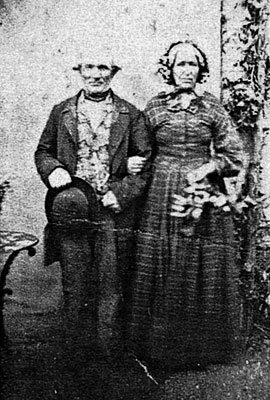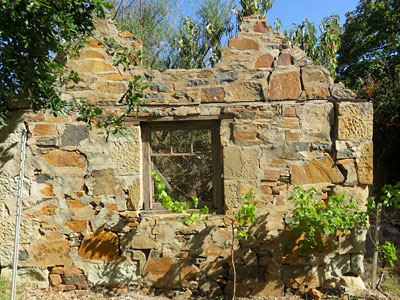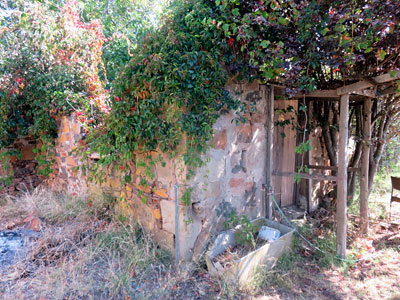Skeggs
Skeggs is the maiden name of one of our maternal great-great-great grandmothers, Elizabeth Skeggs. The sequence of surnames in the five generations between us goes Skeggs-Cain-Cain-Rogers-Rogers-Dwyer.
The surname Skeggs derives from the Old Norse skegg, meaning “beard” denoting someone with a particularly noteworthy beard. The “s” added at the end denotes “son of Skegg”. In the 19th century Skeggs was a fairly common name in Hertfordshire, where our known Skeggs ancestors originated.
John Skeggs (c.1739-1802?) and Ann Rist (1743-1802?)
Our great great great great great great grandparents
John Skeggs was born around 1739, in or near Anstey in Hertfordshire. His parents are unknown. Anstey is a small village almost 60 kilometers north of London on Ermine Street, the Roman road between London and Lincoln. At the time of the 1841 census its population was 497.
Ann (or Anna) Rist was born in Stocking Pelham, Hertfordshire, the daughter of Thomas and Anne Rist, and was baptised there on 8 May 1743. Stocking Pelham is about 8 kilometers south east of Anstey on the Hertfordshire-Essex border.
John and Ann married at Anstey on 8 August 1764 and had two known children:
- John (our ancestor - see below - b.1769)
- Sarah (b.1778)
It is not known when John and Ann died, but they presumably lived their lives at Anstey. Some researchers believe that both of them died in 1802, Ann on 19 September and John on 17 October, but no evidence for this has been cited nor independently sourced.
John Skeggs (1769-?) and Mary Pratt (1778-?)
Our great great great great great grandparents
John Skeggs was born in Anstey, the son of John Skeggs and Ann Rist (see above), and was baptised there on 10 September 1769.
Mary Pratt was born in Anstey, and was baptised there on 30 August 1778. The baptism record only has her mother’s name, also Mary Pratt, which may indicate that Mary was born out of wedlock.
John and Mary married at Anstey 26 December 1796 and had seven children, all born at Anstey:
- Elizabeth (b.1797)
- Sarah (b.1800)
- William (b.1804)
- Mary (b.1806)
- John (b.1808)
- Maria (b.1811)
- Richard (our ancestor - see below - b.1813)
It is not known when John and Mary died, but they presumably lived their lives at Anstey. Based on this location, it is assumed that John Skeggs was engaged in farming.
The Skeggs family lived in or around Anstey until at least 1813. A possible burial record for a Sarah Skeggs in 1825 at Rushden, about 15½ kilometers from Anstey, and a possible marriage record for Elizabeth Skeggs at Westmill, about 9 ½ kilometers from Anstey, indicate that the family was still in the district towards 1830.
There is no record of the death for John Skeggs or for Mary Pratt. There are burial records for both a John and Mary Skeggs at Hunsdon (23 kilometers from Anstey) in 1835 and 1837 respectively, but there were numerous Skeggs families in that area and there is no other known link of John and Mary to Hunsdon.
Richard Skeggs (1813-1883) and Susannah Keep (1812-1874)
Our great great great great grandparents
Richard Skeggs was born in Anstey, the son of John Skeggs and Mary Pratt (see above), and was baptised there on 18 July 1813.
It is known from the 1841 census that Susannah Keep was born in the County of Middlesex, which at that time included a large part of London. It is most probable1 that our Susannah Keep was born on 3 March 1812 the daughter of John William Keep and Susannah Chapman, of Poplar, London. She was baptised at St Dunstan and All Saints, Stepney High Street on 3 May 1812.
Richard and Susannah were married at North Mimms, Hertfordshire on 10 March 1834. They had eight children, the first two born in England and the remainder in Tasmania:
- William (b.1834) – married Bridget Donahoo at Glamorgan, Tasmania in 1856 and they had six children: George (b.1857), William Alfred (1859-1861), John Henry (b.1861), Mary Elizabeth (b.1863), William (b.1867) and Richard Thomas (b.1869). It is not known where or when William died.
- Elizabeth (1838-1894 - our great great great grandmother)
- Thomas (b.1843) – married Elizabeth Anning in Hobart in 1866 and they had six children: William Richard (b.1868), Thomas Henry (b.1870), Charlotte (b.1872), Susan Emily (b.1874) Sarah Elizabeth (b.1876) and Ada Mary (b.1880). Thomas died in Western Australia in 1910 after apparently escaping from the law in Tasmania in 1881.
- Susannah (b.1845) – born on 23 June and baptised at Swansea Parish on 24 August 1845, she married Thomas Fennell in 1869.
- Mary Anne (b.1846) – born on 3 June and baptised at Swansea Parish on 11 July 1846, she married Robert Wright in 1870.
- Richard (1848-1920) – married Mary Ann Sparkes in Spring Bay, Tasmania in 1870. Richard died at South Melbourne in 1920.
- John (1850-1912?) – married Sarah Poole in Glamorgan in 1872 and they had three children: Agnes Susanna (b.1873), John James (b.1875) and Ellen Elizabeth (b.1878). He probably died in 1912 at Oatlands, Tasmania.
- Robert (b.1852) – married Sarah Cole in Glamorgan in 1873 and they had seven children: Ellen (b.1875), “F Skeggs” (b.1877), John Richard (b.1878), Robert James (b.1883), William Oren (b.1888), Albert Ernest (b.1890) and George Henry (b.1893). Robert Skeggs died in 1929 in the Royal Hobart Hospital and Sarah (Cole) Skeggs died in 1923 at Swansea Tasmania. They are both buried in the Church of England cemetery at Swansea. See photo of Robert and Sarah.
At the time of Elizabeth’s baptism the family was living at Dugdale Hill, Middlesex. In the 1841 England census they were living in Friern Barnet, Middlesex, about 14 kilometers north of London. Richard was noted as being an agricultural worker, but no occupation was given for Susannah.
In 1842 Richard, Susannah and their two children left England aboard the Orleana as bounty immigrants to Tasmania. The Orleana, a ship of 649 tons, departed Plymouth on 21 March 1842, Alex. Cameron, Master, with 276 emigrants (89 men, 78 women and 189 children).2 This voyage was the first of bounty immigrants to Tasmania, and it arrived in Hobart on 4 July 1842. Clearly the organisation around bounty or assisted immigrants in 1842 was not as well-oiled as it was later to become:
THE IMMIGRANTS. The whole of the single immigrants by the Orleana have already obtained good situations; we hope those who are married and have families will soon be similarly situated. When the next immigrant ship arrives, we trust the Government will at once, have them landed and placed in a house of refuge; this will give fair play to female heads of families, who cannot conveniently go on board ship to hire servants.3
Weekly List of Immigrants remaining in the Immigration Quarters, Hobart Town, applying for employment, Wednesday, 20th July, 1842: Richard Skeggs, wife and two children, first class farm servant, good character...4
It was reported on 19 August that all immigrants had been "disposed of".
Richard and his family went to the Oyster Bay area on the east coast of Tasmania where he worked for George Meredith as a farm servant for a salary of £26 per year. Meredith (1777-1856), an officer in the Royal Marines during the Napoleonic Wars, had come to Tasmania and settled in Oyster Bay in the early 1820s. In 1825, when Meredith himself was absent, his homestead was attacked by the bushranger Matthew Brady and his gang. In 1836 Meredith moved into a large house which he named Cambria.5
In the 1848 Tasmania census Richard, Susannah and their children William, Elizabeth, Thomas, Susannah and Mary Ann are shown as living in a brick dwelling owned by George Meredith.
 |
This photo is believed to be of Richard Skeggs and Susannah Keep in 1865. It was sent to us by a direct descendent of the Thomas (born 1843) to whom the inscription on the back is addressed. This inscription says "Thomas Skeggs father and mother, Swanport, 29 January 1865, My dear son, this is your father and mother, forget me not, Swanport, 29 January 1865". The inscription on the back of the copy was in modern handwriting, and was most likely copied by the person who had photocopied the original photo. Unfortunately, it is impossible to verify the inscription or the original photo itself, however it is believed to be from a very reliable source and since then another relative has told us that they have this photo with the same inscription. There is some resemblance between this man and the photo of his son Robert Skeggs.
|
After George Meredith’s death, it seems that Richard Skeggs worked for George’s son, John Meredith. Richard was obviously very handy with a plough, winning £5 for 3rd place in ploughing match on 15 September 1857, fourth place in a ploughing match on 15 September 1858, £6 for first place in ploughing match on 10 September 1862, first place in a ploughing match on 7 October 1870 and £4 for 3rd place in ploughing match on 3 October 1873.6
Susannah Keep died at "Glen Gala" Cranbrook, Swansea, Tasmania on 22 May 1874 aged 62, and was buried at All Saints Swansea on 27 May. Richard Skeggs died in the Charitable Institution in Newtown , Hobart on 12 December 1883.


Current photos of the old workers' cottage at
"Glen Gala" which is most likely where Susannah died. Richard and Susannah worked on this property and most likely lived in this cottage.
Photos provided by Rhonda Lynch.
1 There was also a Susanna Keep, the daughter of William and Sarah Keep of Tottenham Court Road, London, who was baptised at St. Giles in the Fields, Holborn on 4 July 1813. It is believed, however, that this Susannah Keep (then spelt with an ‘h’) married a George Hardy in Holborn in 1833
2 Colonial Times, Tuesday 5 July 1842.
3 Colonial Times , Tuesday 12 July 1842.
4 The Gazette, Colonial Secretary's Office, 18 July 1842, printed in Colonial Times, Tuesday 26 July 1842.
5 http://adb.anu.edu.au/biography/meredith-george-2449
6 Colonial Times, Monday 21 September 1857; Launceston Examiner, Saturday 9 October 1858; The Mercury, Wednesday 17 September 1862; The Mercury, Saturday 15 October 1870, p.3; Launceston Examiner, Saturday 18 October 1873, p.5.